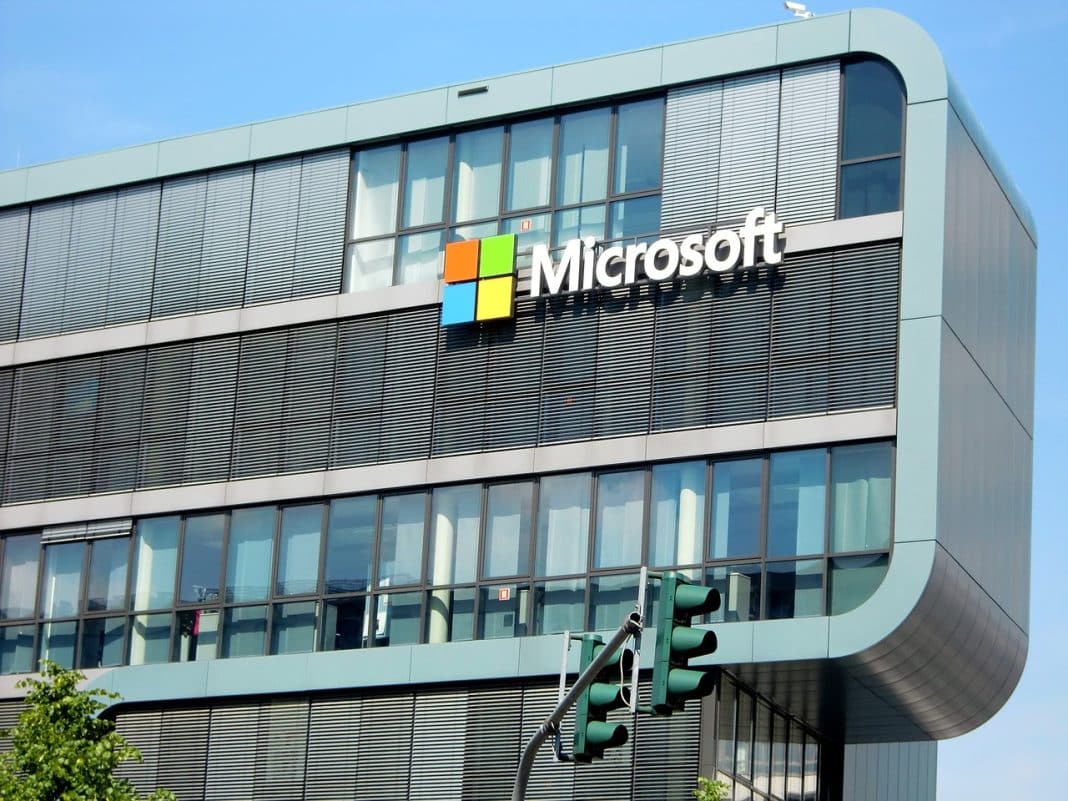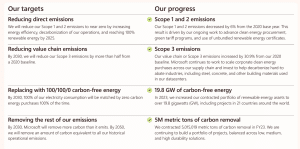Microsoft’s Financial Success
Microsoft’s 2030 Carbon Negative Goal
Microsoft has set an ambitious goal to become carbon negative by 2030, meaning the company aims to remove more carbon dioxide from the atmosphere than it emits. By 2050, Microsoft plans to offset all carbon dioxide emissions since its inception in 1975. Achieving this involves significant innovation and collaboration, particularly in the face of complex emission challenges.
Since setting its sustainability targets 4 years ago, Microsoft has been at the forefront of efforts to address climate change. Thousands of other companies have also committed to achieving net zero emissions, driven by advancements in technologies such as AI, which enhance measurement, datacenter efficiency, and energy transmission.
Amid financial success, the key environmental challenge of reducing Scope 1, 2, and 3 emissions remains substantial.
In FY23, Microsoft’s total emissions rose by 29.1% compared to the 2020 baseline. This increase is attributed to ongoing investments in technology and infrastructure to support future innovations.
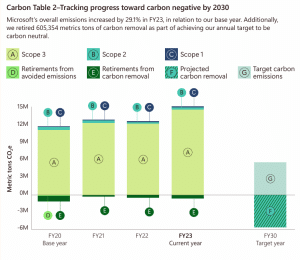
Notably, Scope 3 emissions account for more than 96% of Microsoft’s total emissions. These emissions primarily come from two upstream categories: Purchased Goods and Services (Category 1) and Capital Goods (Category 2), as well as one downstream category: Use of Sold Products (Category 11).
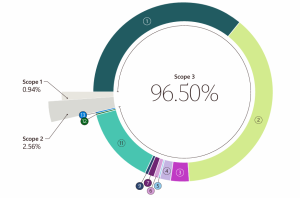
Although Microsoft has reduced Scope 1 and 2 emissions by 6% since 2020 through efforts such as clean energy procurement and green tariff programs, Scope 3 emissions remain the biggest challenge. Addressing these requires extensive collaboration across industries.
What’s Microsoft Doing About Its Increasing Carbon Footprint?
Microsoft’s goal of becoming carbon-negative is deeply connected to global decarbonization efforts. Essential to this goal is supporting the development of carbon-free electricity infrastructure through procurement and investment. Recognizing the scale of this challenge, Microsoft has adopted a pioneering approach by investing in carbon-free electricity to enhance the grids where it operates.
The company is also working to diversify and expand the supply of impactful renewable energy and improve access for all.
Scaling Up Clean Energy
Microsoft’s partnership objectives are to meet its own operational needs, accelerate the development of technologies for its customers and partners, and significantly increase the global sustainability market.
- By 2023, Microsoft had expanded its renewable energy portfolio to over 19.8 gigawatts (GW) across 21 countries.
New power purchase agreements (PPAs) were signed with AES in Brazil, Constellation Energy in Virginia, Powerex in Washington, Contact Energy in New Zealand, and Lightsource bp in Poland.
Notably, Microsoft became the first major commercial entity to use Powerex’s 24×7 Clean Load Service for a datacenter in Washington. This service matches Microsoft’s hourly datacenter energy demand with direct deliveries of carbon-free hydro, solar, and wind power year-round, supporting the company’s 100/100/0 goal.
Datacenter Efficiency
Microsoft is optimizing datacenter efficiency using Power Usage Effectiveness (PUE) with a current design rating of 1.12, aiming for even lower values. Transitioning servers to low-power states reduced energy use by up to 25%, cutting Scope 2 emissions.
The company also enhances resource utilization by minimizing peak power needs and improving server density, leading to a 7% reduction in datacenter power infrastructure. Additionally, server utilization improvements resulted in a 1.5% reduction in hardware needs for Azure, significantly reducing embodied carbon.
Fleet Electrification
Microsoft is advancing its fleet electrification efforts across global campuses, aiming to eliminate reliance on fuel-burning vehicles. To achieve a 100% electric fleet by 2030, Microsoft is building an Electric Vehicle Fleet Facility at its Redmond headquarters. This facility, currently in the design phase, will support the electric fleet by providing housing, charging, and maintenance services.
Boosting Carbon Dioxide Removal (CDR) Solutions
To address its unavoidable emissions, particularly Scope 3, Microsoft is committed to advancing carbon removal technologies.
In FY23, the company accelerated procurement across various CDR pathways, leveraging a long-term agreement framework to enhance the impact of large-scale projects. These multi-year agreements are designed to help projects secure external financing and ensure the purchase of additional, durable, measurable, and net-negative carbon credits.
Microsoft’s goal is to build a portfolio of over 5 million metric tons per year starting in 2030, while also exploring novel solutions such as enhanced rock weathering.
In FY23, Microsoft bought 5.015 million metric tons of carbon removal to support its carbon neutral and negative targets.
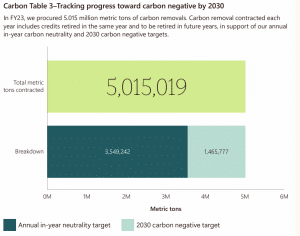
Microsoft contracted 5,015,019 metric tons of carbon removal to be retired over the next 15 years. By December 2023, contracts are expected to contribute 875,000 metric tons towards the 2030 target of over 5 million metric tons. Notable projects signed in 2023 include:
- Reforestation in the Amazon
- Landmark bioenergy with carbon capture and storage (BECCS) in partnership with Orsted
Additionally, Microsoft expanded its renewable energy portfolio to over 19.8 gigawatts, reinforcing its commitment to sustainable energy infrastructure.
And just last month, Microsoft signed two separate CDR deals. One is with BTG Pactual Timberland Investment Group for 8 million carbon removal credits, the biggest CDR transaction on record. The other agreement is with Indigo Ag for 40,000 agricultural soil carbon credits, also the biggest-ever purchase of an individual buyer from the ag company.
With record earnings and significant investments in carbon emission reductions, Microsoft continues to lead in both innovation and sustainability, setting a benchmark for the industry.

